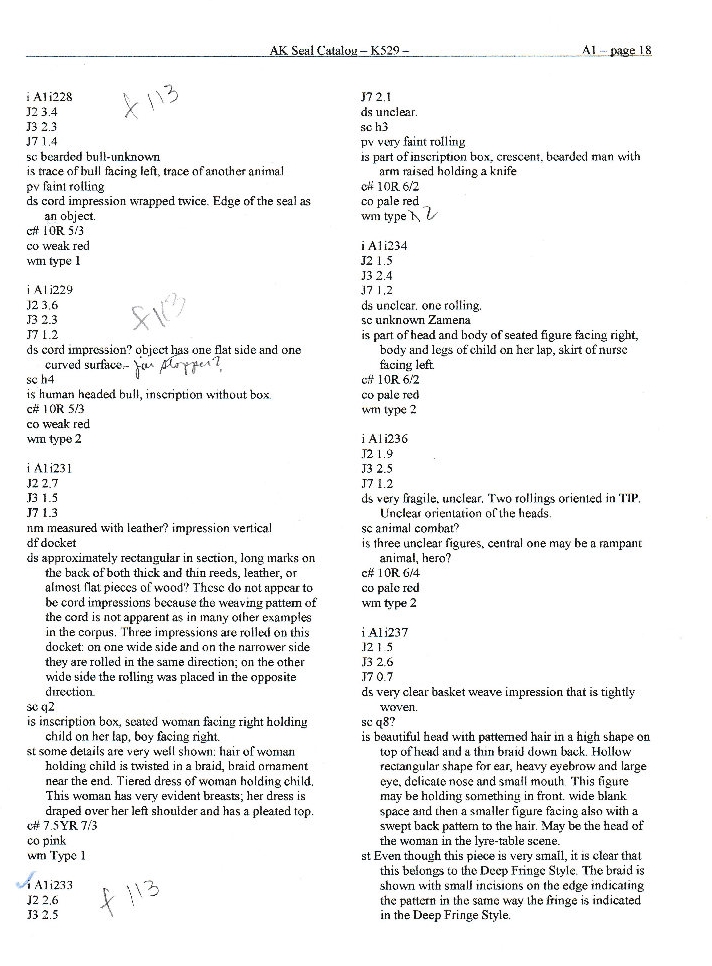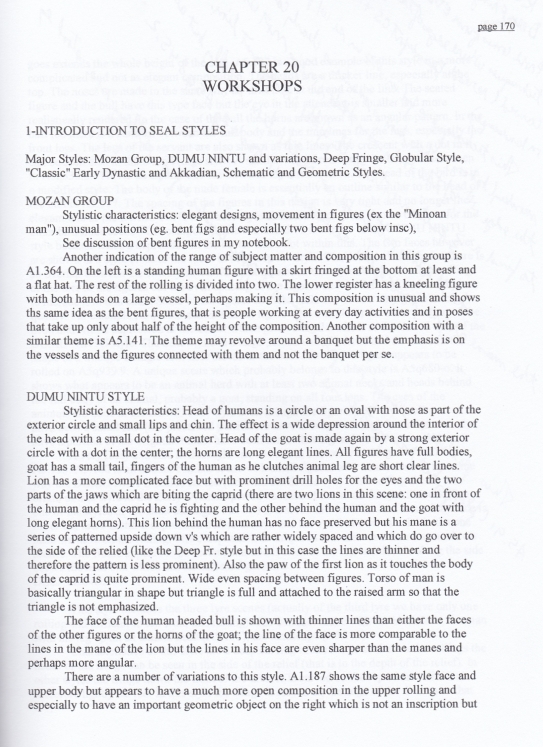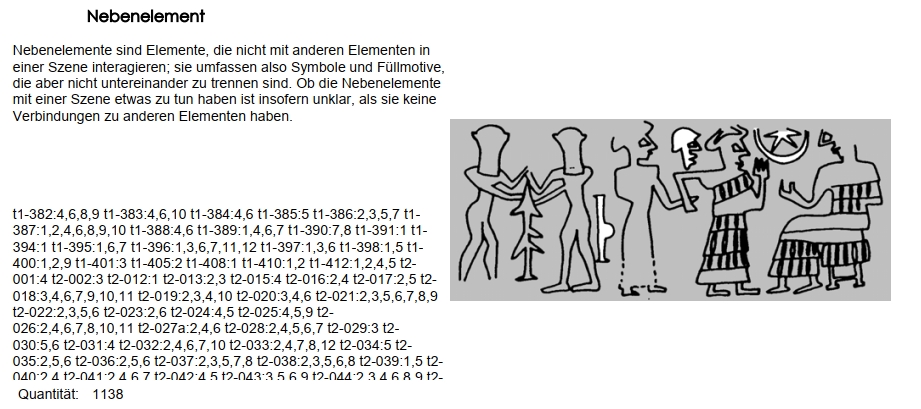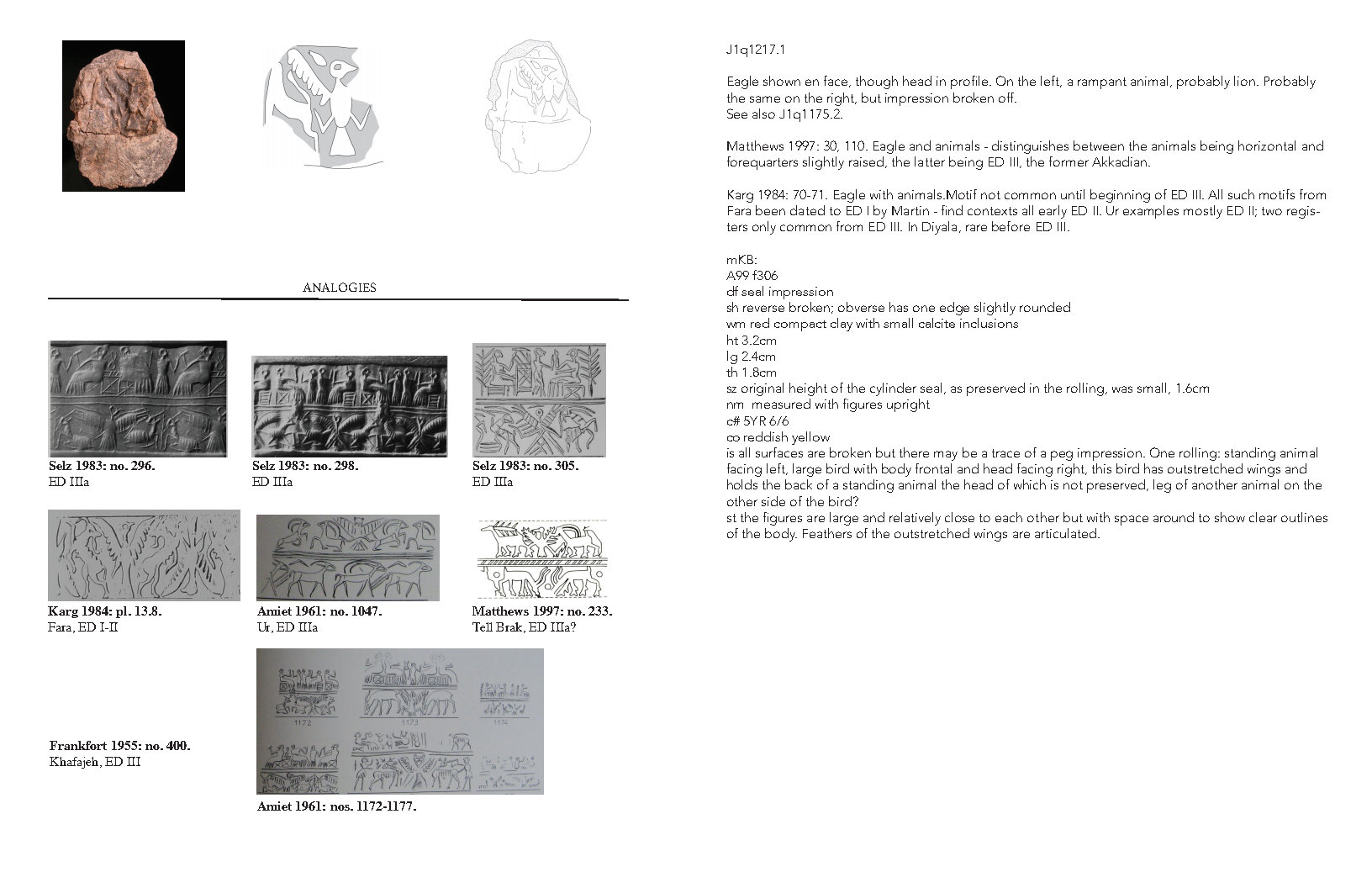Back to top: Project's history: the Seals domain
Back to top: Project's history: the Seals domain
1975-90: Seals project
The Old Babylonian Seals Project was undertaken by Marilyn Kelly-Buccellati, partly in connection with a series of seminars she held with her students in the Department of Art History at California State University Los Angeles. The project focused on the Old Babylonian seal corpus published in museum catalogs. The choice of this time period was based on the fact that we were excavating Old Babylonian strata in the ancient city of Terqa, located next to the Euphrates River in the southeastern portion of Syria. While from this excavation we did not discover many cylinder seals we did find a number of cuneiform tablets which had a number of sealings rolled on them. Since the tablets were for the most part contracts for the sale of land, they required a number of witnesses to seal the tablet containing the contract. The seals of these witnesses were usually rolled on the vertical face or along the edge of the contract tablet. Usually the name of the witness was also inscribed in very small cuneiform signs next to the seal rolling. Sealings have the advantage that usually the context is known whereas museum collections of seals usually are without context.
M. Kelly-Buccellati organized a standing research group starting about 1975 and continued to about 1990. During this whole period the collaborators were Arlene Harris and Eunice Saver who both also participated in our excavations at Terqa. Additionally Peggy Polinger and Stephanie Serlin contributed to this research project for this whole period. For the Terqa seal impressions on the tablets and for each museum seal catalog we divided the work among the group and met usually one afternoon a week for an hour or two to check each other’s analysis. From the beginning an inventory of seal motifs, both the overall design of the seal composition and the individual elements was developed by the group.
This catalog was the focus of the MA thesis of Arlene Harris; her research was part of her MA which she did under M. Kelly-Buccellati’s direction in the Art Department of California State University Los Angeles.
The approach we used included the development of a roster and lexicon which were fundamental for our arriving at a hermeneutic understanding of the inherent meaning of the seal composition and the main figures contained in the composition as well minor elements and filler motifs. This structural approach helped to establish the component parts as well as determining the boundaries separating these parts so that one could arrive at a more comprehensive understanding of each seal as a whole.
Back to top: Project's history: the Seals domain
1977: Marilyn Kelly-Buccellati, Towards the Use of Quantitative Analysis in Mesopotamian Sphragistics (online)
An important programmatic article, it describes first the theoretical aspects underlying any categorization system, and it gives an overview of the comprehensive attribute system designed for the Old Babylonian corpus. In the second part, a case study is offered regarding the relationship of figurative elements with the mention of divine names in the inscription.
[The article refers in note 2 (p. 45) to the project Cybernetica Mesopotamica within which the seals project as envisaged at the time was to be developed.]
Back to top: Project's history: the Seals domain
Back to top: Project's history: the Seals domain
1987: Arlene Harris, Studies in the Iconography of Old Babylonian Cylinder Seals
M.A. thesis, California State University, Los Angeles (PDF).
The thesis gives an exhaustive presentation of both the roster and the lexicon as applicable to the Old Babylonian corpus of cylinder seals. As indicated in the conclusion: “My intent is not to present exhaustively all meaningful design correlation in our data base, but to demonstrate the comprehensiveness and flexibility in the data base of our encoding system. These two examples, Adad and the bowlegged dwarf, demonstrate how the corpus can be used to confirm or deny questions asked of the database and demonstrate its usefulness and indeed necessity in the study of iconography of any tradition for which we do not have native informants” (p. 141).
Here are two samples from the “dictionary”, relating one to major compositional elements and the other to attributes:
As an example, Harris’es analysis shows (pp. 131-133), on the basis of the encoding of a corpus of 1159 seals, of which 518 are inscribed, that there is, contrary to the then current opinion, a direct correlation between the representation of a given divine figure (Adad, in this case) and the legend inscribed on the seal.
Back to top: Project's history: the Seals domain
1996: Lily Tsai, Computer Analysis of Akkadian Art Based on Recent Excavated Urkesh/Mozan Seal Impressions and Seals in Major Museum Collections
M.A. thesis, California State University, Los Angeles (PDF).
This thesis expands the categorization system presented by Harris for the Old Babylonian period to include seals from the Akkadian period, with particular reference to the evidence from Urkesh and Tell Brak. On this basis, Tsai was able to formulate some new conclusions about the nature of iconographic choices Akkadian seal cutters made.
The first image below shows a comparison of motifs between Akkadian and Old Babylonian seals, the second a complete index of motifs in Mozan and Brak, and the third the frequencies of given iconographic motifs.
Back to top: Project's history: the Seals domain
Back to top: Project's history: the Seals domain
2000: M. Kelly-Buccellati UTR 1. Seal Impressions from the Service Wing AK
Back to top: Project's history: the Seals domain
The corpus
A comprehensive study of all seal impressions from the service wing (AK) of the Royal Palace of Tupkish. 1990-1999 ExcavationsPalace of Tupkish, for a total of 1219, divided as follows by excavation unit:
| A1 |
283 |
| A1q |
315 |
| A2 |
6 |
| A5 |
180 |
| A6 |
151 |
| A7 |
168 |
| A8 |
18 |
| A9 |
50 |
| A10 |
46 |
| A11 |
2 |
| Total |
1219 |
Back to top: Project's history: the Seals domain
The “Urkesh Typological Record” (UTR)
The work consists of two volumes. They were intended for publication in a projected series, to be entitled “Urkesh Typological Record.” Even though this two volume work was close to publication, it was decided to wait until a proper digital channel could be found for the same. It is only now that we come back to this particular project.
The first volume has 211 pages of text, and is subdivided into three parts (see presently).
The second volume contains drawings for each of the seal impressions. The drawings are all inclusive of the details of the sealing on which the seal had been rolled (see the example given below.)
Back to top: Project's history: the Seals domain
Scope of the book
The book was the result of a major ongoing research by the author on the Urkesh glyptics. It was not completed for publication, largely because at that time we were developing the browser version of the same, and all energies were put on that project. Thus the whole idea of a series of Urkesh Typological Reports, of which this was going to be the first volume, was set aside.
The Table of Contents (below) is indicative of the richness of the material included. It is briefly illustrated in the following paragraphs.
Back to top: Project's history: the Seals domain
Part One. Catalog
Here one will find a complete documentation of all 1219 seal impressions found in area AK.
The format is preparatory for processing by the JD program that produces the display format of the individual unit books. But all the information is present that one would normally find in a printed catalog.
In the current version, the seal impressions are listed by the excavation unit in which they were found, with their initial field numbers. The text gives the relevant statigraphic information (more will be found in the individual page for each item) and the full typological description.
|
|

|
Back to top: Project's history: the Seals domain
Part Two. Iconography and style
This section (which remains largely incomplete) groups the iconography of the seal impressions by type, in three major categories:
- First are the scenes that are accompanied by a legend, which allows us to identify the owner of the seal. These are respectively the king, the queen (see the sample page to the right) and the courtiers.
- Second are the uninscirbed seals that can be attributed to a deity on the basis of specific iconographic traits known to be associated with these deities.
- Finally there are the uninscribed seals divided according to the nature of the scene represented: general activities, combats and miscellaneous.
|
|

|
Back to top: Project's history: the Seals domain
Part Three. Contextual analysis
The second part of the book presents an in depth study of some major categories of data and of their implications for an understanding of the history of Urkesh as a whole, in the following chapters:
- Workshops: on the basis of the iconography and the examination of the seal traces on can reconstruct specific workshops where the seals were made (see the page reproduced below).
- Horizontal distribution of the seals impressions in the respective rooms where they were found.
- Sealing practices and functions: given the abundant presence of legends on many seals, it is possible to reconstruct the way in which different court members and functionaries were present within the palace economy.
- Chronology: considerations based on the tight stratigraphic definition of the sealings.
- Historical setting: considerations based on the nature of the building (the royal palace) where the sealings were found.
- Symbols and symbolism. Going beyond the grammatical description of the iconographic motifs, one finds here a semiotic or iconological study of their deeper meaning (see the page reproduced below.)
- The secular world of Urkesh.
- Conical cups and drinking ceremonies: this and the following chapter take up and discuss in full two particular iconographic types.
- The bird table.
- Urkesh: Its contemporaries and legacy. A comparative study of the very characteristic Urkesh glyptic style with other contemporary corpora and of its significance within the broader historical development of Syro-Meospotamian art.

|

|
Back to top: Project's history: the Seals domain
Methodology
The book is based on the categorization system that was being developed at the same time for the glyptic analysis to be applied in the field, in particular the lexicon, as obviously applicable also to seals and seal impressions from other areas of the site besides the service wing of the Palace.
Back to top: Project's history: the Seals domain
Relevance for the Cybernetica Mesopotamica project
The two volume work served as the backbone for all subsequent work on the Urkesh glyptic corpus, such as is now taking shape in the expanded glyptics digital book, which is described separately below under “Goals”.
Back to top: Project's history: the Seals domain
2004: Urkesh Seal Dictionary
Within the framework of a graduate seminar, M. Kelly-Buccellati developed an extensive figurative lexicon for the Urkesh corpus. As a sample of the results we may refer to the lexicon prepared by Tarsy Lin (40 MB).
Back to top: Project's history: the Seals domain
2006: Federico Buccellati, Altassyrische Glyptik. Eine inhaltliche und methodologische Annäherung
Back to top: Project's history: the Seals domain
Database and grammar
A comprehensive database is assembled, containing 429 seals that have been considered as Old Assyrian in the literature.
A highly detailed categorization system is developed, with a total of 236 attributes and as many as 4,084 elements.
Back to top: Project's history: the Seals domain
Methodology
Importantly, the distinction is made between a formal definition and a more interpretive approach: «It is important to define the elements as figures and not through their symbolism», since the latter belongs in the «synthetic» rather than the «analytical» part (4.5.2). For example, rather than naming a figure as “Adad,” one should only refer to it as a riding figure holding a thunderbolt.
It is a deductive method, that accomplishes however the goal of producing a synthesis, where frequencies of attributes can be easily and objectively charted. The expliciteness in describing the categorization system makes it an open system that can be used for future enhancements (4.5.3-4).
Back to top: Project's history: the Seals domain
Attribute analysis
Attributes («Eigenschaften») are assigned to either the seal as such or to the individual compositional elements. The latter category includes nine groups of attributes. The first is the nature of the element itself, depending on whether it serves a primary or secondary function on the scene, or on whether it is an object integrated in the scene or a mere filler motif. As an example, we may look at the entry for a filler motif («Nebenelement»):

In this example there are three filler motifs (shown in white in the drawing); a description of the element, and a list of all the instances where the element occurs, for a total of 1,138.
The same is done for:
- iconographic meaning (72 attributes);
- the placement within the composition (7 attributes);
- the position of a figure vis-àvis-another (12 attributes);
- the direction faced by the figures (15 attributes);
- the head covering (18 attributes);
- detail of clothing (17 attributes);
- the position of the hands (6 attributes);
- correlation with other elements (individually assigned);
Back to top: Project's history: the Seals domain
Relevance
The effort goes well beyond the standard catalog. By applying a highly detailed categorization system to each one of the 429 items in the corpus, a very comprehensive formal analysis is possible of the great variety of figurative elements, on which a hermeneutic analysis can further be applied to achieve a full iconographic analysis, with all the objectivity that is possible for a broken tradition such as that of the Old Assyrian period.
This was particularly significant given the high number of items in the corpus and the clear definition of its chronological and geographical boundaries.
Back to top: Project's history: the Seals domain
The digital aspect
The database was produced with Microsoft Access, and the advantages of the approach are stressed (4.3). However, given the early date of this work, it was not possible to assure a proper dissemination of the data, so that in effect the paper copy of the thesis is the only format in which it has been de facto accessible.
The author plans now to revise the work with a view towards making it accessible in a website format consonant with the goals of the Cybernetica Mesopotamica Balzan project.
Back to top: Project's history: the Seals domain
2018: Laerke Recht, ED III seal impressions
A collection of 68 seal impressions from Urkesh in the ED III period was collected by Laerke Recht, with all the information available at the time, a full typological description by Marilyn Kelly-Buccellati for several items in the standard UGR format, and comparative material assembled by Laerke Recht. They are thus ready for a full figurative and iconographic analysis.
The image below is the entry for one of the seals included, as an example of how the material is organized.

Back to top: Project's history: the Seals domain